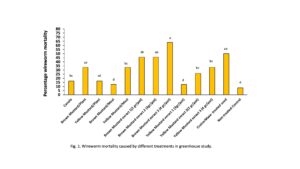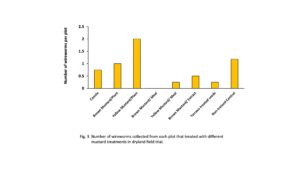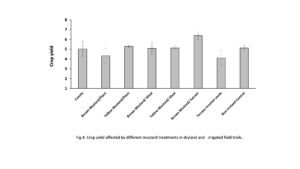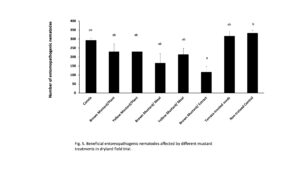Final report for GW20-206
Project Information
In recent years, cereal production in the Pacific Northwest and Intermountain regions of the USA has been threatened by the re-emergence of a devastating pest, known as wireworm. Neonicotinoid seed treatments, and until recently the only group of insecticides registered in cereals against wireworms, have failed to deliver acceptable levels of protection. There is currently an urgent need to develop alternative control methods to be used as components of an integrated pest management protocol against this pest. Cruciferous plants are known for their biocidal effects on a wide range of pest conditions (e.g. weeds, insects, pathogens) due to their glucosinolate contents. Here, in a series of greenhouse assays and field trials, we examined the effects of different mustard species as rotation/cover crops (soil incorporated), as well as their defatted seed meals in reducing wireworm populations, thus damage. For the first time, we also tested the efficacy of a newly developed concentrated seed meal extract (brown mustard) against wireworms. Further, we examined the potential impact of our treatments on the beneficial entomopathogenic nematodes, which are locally present as natural enemies of wireworms. This experiment was performed in one irrigated (yield data only) and one dryland (yield, wireworm, and entomopathogen estimates) field. In the greenhouse, the concentrated seed meal extracts of brown mustard caused significant mortality levels in wireworms (all application rates). In the field, the application of mustard treatment (brown or yellow mustard) did not result in a significant improvement in yield. In the irrigated field, however, plots treated with the concentrated extract of brown mustard tended to have higher yield. In our dryland plots, the brown mustard concentrated extract had a significantly negative impact on entomopathogenic nematode numbers.
The overall goal of this project is to explore an alternative integrated management tactic to control wireworms in cereal crops. We will achieve this goal through two complementary objectives. Our third objective is designed for effective delivery of findings to our regional stakeholders.
Objective 1: Evaluate the effect of mustard species including yellow (Sinapis alba) and brown (Brassica. juncea) mustard against wireworm, our sub-objectives are set as below:
1a. Investigate the effectiveness of cover crop (soil incorporated as green manure), defatted seed meals and concentrated extracts of yellow (S. alba) and brown (B. Juncea) mustard species to reduce wireworm damage in wheat under greenhouse conditions.
1b. Evaluate and compare the effectiveness of brown (B. juncea) and yellow (S. alba) mustard rotations, and mustard species products) in reducing wireworm damage to wheat.
Objective 2: Compare entomopathogenic nematode presence and infectivity following yellow and brown mustard treatments, and in relation to non-treated controls.
Objective 3: Disseminate findings to stakeholders and growers and promote adoption of successful IPM tactics against wireworms.
This project not only examines the effectiveness of alternative approaches to reduce wireworm pressure but also aims to increase growers’ knowledge of an alternative to paraphyletic application of synthetic insecticides to promote sustainability of our management practices.
Studies on the efficacy of mustard and mustard products have yielded conflicting results. The species of mustard and targeted wireworm, environmental conditions and timing of application have been proposed as potential variables that can explain the inconsistency in outcomes. In this proposal, focusing on a single wireworm species, sugar beet wireworm, we will evaluate the efficacy of both yellow and brown mustard species, their seed meals, as well as the newly developed concentrated extracts for each of the two species (containing higher concentrations of glucosinolates), while taking into consideration, any potential side-effects on beneficial entomopathogenic nematodes.
Cooperators
- - Producer
- - Producer
- - Producer
- (Educator)
Research
Objective 1: To evaluate the effects of different mustard species and their products against wireworms, we conducted a series of greenhouse and field trials.
Subobjective 1a. Greenhouse studies were developed to minimize the effect of environmental variables and to determine wireworm response to mustard products in the absence of environmental variability. Experiments were conducted at the University of Idaho’s Manis Greenhouse in Moscow, ID. Square plastic pots in the size of 10.16 * 10.16 * 12.7 cm (W* L* H) were selected as experimental pots. Experimental pots were filled with sand-dominated media (70% sand and 25% peat moss). The mixed soil also contained 228 g of vermiculate (Therm-O-Rock West., Chandler, AZ) and 112g of fertilizer (15-9-12 [N-P-K]; Osmocote, Scott-Sierra Horticultural Products, Marysville, OH) per 22 kg of the load. The sugar beet wireworm, Limonius californicus, was used in this experiment. There were 13 treatments: 1) yellow mustard soil-incorporated plant tissue; 2) brown mustard soil-incorporated plant tissue; 3) canola soil-incorporated plant tissue as control; 4) yellow mustard seed meal applied at the rate of 8.9 t/ha (8 g/pot); 5) brown mustard seed meal applied at the rate of 8.9 t/ha (8 g/pot); 6) brown mustard concentrated seed meal extract applied at the rate of 2.2 t/ha (2 g/pot); 7) brown mustard concentrated seed meal extract applied at the rate of 3.3 t/ha (3 g/pot); 8) brown mustard concentrated seed meal extract applied at the rate of 4.5 t/ha (4 g/pot); 9) yellow mustard concentrated seed meal extract applied at the rate of 2.2 t/ha (2 g/pot); 10) yellow mustard concentrated seed meal extract applied at the rate of 3.3 t/ha (3 g/pot); 11) yellow mustard concentrated seed meal extract applied at the rate of 4.5 t/ha (4 g/pot); 12) neonicotinoid seed treatment (CruiserMaxx) and 13) non-treated control. This study was conducted in three time-blocks, with 8 replicates per treatment in each time-block. Yellow mustard (Sinapis alba), brown mustard (Brassica juncea), and canola (Brassica napus) were planted in pots 8 weeks before starting the experiment. At flowering, plants were chopped and mixed onto the potted soil. At the same time, seed meal and concentrated extract of both brown and yellow mustard were added and mixed into the soil for respected treatments. All pots were sealed with parafilm for 24 hours. 300 ml water was added to each pot; in the presence of water, glucosinolate compounds in brown (sinigrin) and yellow (sinalbin) mustard hydrolyze and release the biologically toxic compounds (Popova et al. 2017). Seed meals of both brown and yellow mustard were applied at the rate of 8.9 t/ha (8 g per pot)(Dandurand et al. 2017). Concentrated seed meal extract is a newly developed product and there was no recommended application rate against wireworms. We applied this product at the rates of 2.2, 3.3, and 4.5 t/ha (2, 3, and 4 g per pot, respectively), similar to those applied in (Dandurand et al. 2017) against potato cyst nematodes. A single sugar beet wireworm was placed in each pot immediately after applying the treatments and prior to covering the pots. To minimize phytotoxicity, wheat was planted 14 days after the soil treatments. With the exception of CruiserMaxx treatment, four untreated winter wheat seeds of the cultivar, SY-Ovation, were planted in each pot. CruiserMaxx was applied at the rate of 325 ml/100 kg seeds (CruiserMaxx treatment, only). Pots were arranged in a completely randomized design. After four weeks, emergence rate (percent germination), damage rate (percent damage), and wireworm mortality were recorded. Live wireworms were placed individually in the sand-filled containers and monitored for two weeks for additional mortality.
Statistical analysis was performed in IBM-SPSS (ver. 26). Generalized Linear Mixed Model (GLMM) was used to compare the effects of applied treatments (fixed effect) and time-block (random effect) on wireworm mortality (binomial response).
Subobjective 1b. An on-farm trial was conducted in two wireworm-infested dryland fields and one irrigated field in south-central (1) and southeastern (2) Idaho in Spring 2021. All three fields have been monitored for the presence of wireworms for the last two years. Sugar beet wireworm, Limonius californicus was the most abundant wireworm species in all of our experimental fields.
Study sites: 1) Hans and Twain Hayden field, Arbon Valley, Power Co., southeastern Idaho, 2) Kimberly R&E Center, Kimberly, Twin falls Co., south central Idaho. The Kimberly field site was added due to its heavy infestation, and the uncertainty about precipitation in dryland (see below).
Due to very low precipitation and the unusually high temperatures across the state in summer 2021, mustard seed germination was not uniform across locations and resulted in poor stands in our two dryland locations. As such, we dropped one of the fields and added an irrigated field to ensure mustard development.
A total of nine treatments with four plot-replicate per treatment were planned in each location. Treatments included: 1) winter fallow followed by Teraxxa-treated spring wheat; 2) winter fallow followed by non-treated spring wheat; 3) winter brown mustard (Brassica juncea) followed by non-treated spring wheat; 4) winter yellow mustard (Sinapis alba) followed by non-treated spring wheat; 5) winter canola (Brassica napus) followed by non-treated spring wheat; 6) brown mustard seed meal at the rate of 37.8 lb/plot followed by non-treated spring wheat; 7) yellow mustard seed meal at the rate of 37.8 lb/plot followed by non-treated spring wheat; 8)brown mustard concentrated seed meal extract at the rate of 18.9 lb/plot followed by non-treated spring wheat ; 9) winter fallow followed by brown mustard concentrated seed meal extract applied in spring at the rate of 18.9 lb/plot/ non- treated spring wheat. Plots were 10 * 20 ft in size, arranged in a randomized complete block design, with four replicates per treatment. Two weeks before planting all plots were sprayed with Roundup (Glyphosate, Bayer CropScience, CA) to remove weeds. Wireworm numbers were estimated in each plot before planting by using solar bait traps according to Rashed et al. (2015). Spring canola, brown and yellow mustard were planted in the first week of May 2021 at the rate of 12 seed/ft in 1-1.5-inch depth. We proposed to chop and incorporate planted mustard plants into the soil right after flowering. Planted canola, yellow mustard, brown mustard and applied treatments (seed meals and brown mustard concentrated extract) incorporated into the soil within 2 hours after application using disk cultivator. All plots stayed fallow in winter and followed by spring wheat, which was planted in late April. Teraxxa- treated treatment added to experiment as a no-wireworm control treatment. Broflanilide (Teraxxa) is a newly registered insecticide in cereal crops against wireworms with the suggested mortality effects more than 80%. To evaluate the efficacy of applied treatments, the wireworm population have evaluated in two weeks after planting in spring using one solar bait trap in each plot (dryland).
Objective 2: To address objective 2, evaluating the impacts of the application of mustard products on beneficial entomopathogenic nematode in the experimental plots, we took two soil samples from each plot using a 6-inch augur, one to two weeks week after incorporating mustard and applying mustard products. Soil samples were mixed, and a subsample of 250 g of soil was transferred to plastic containers and five waxworms were placed in each container. After 2-3 days, dead larvae were transferred to White traps (White 1927) individually and monitored for nematode infection. This objective was only completed in the dryland plots. The number of infective juveniles collected from one single infected waxworm in 1000 µl suspension was counted and the average of nematodes recovered is used to estimate the nematode population in each experimental plot in relation to the nontreated controls.
References
Dandurand, L.-M., Morra, M. J., Zasada, I. A., Phillips, W. S., Popova, I., & Harder, C. (2017). Control of Globodera spp. Using Brassica juncea seed meal and seed meal extract. Journal of Nematology, 49(4), 437.
Furlan, L., Bonetto, C., Patalano, G., & Lazzeri, L. (2004). Potential of biocidal meals to control wireworm populations. Proceedings of the First International Symposium on “Biofumigation: A Possible Alternative to Methyl Bromide, 31, 313–316.
Hansson, D., Morra, M. J., Borek, V., & Eigenbrode, S. D. (2013). Green peach aphid [Myzus persicae (Sulzer)(Hemiptera: Aphididae)] control using Brassicaceae ethyl ester oil sprays. Journal of Applied Entomology, 137(7), 530–539.
Lichtenstein, E. P., Morgan, D. G., & Mueller, C. H. (1964). Insecticides in nature, naturally occurring insecticides in Cruciferous crops. Journal of Agricultural and Food Chemistry, 12(2), 158–161.
McCaffrey, J. P., Williams III, L., Borek, V., Brown, P. D., & Morra, M. J. (1995). Toxicity of ionic thiocyanate-amended soil to the wireworm Limonius californicus (Coleoptera: Elateridae). Journal of Economic Entomology, 88(4), 793–797.
Mojtahedi, H., Santo, G. S., Hang, A. N., & Wilson, J. (1991). Suppression of root-knot nematode populations with selected rapeseed cultivars as green manure. Journal of Nematology, 23(2), 170.
Mojtahedi, H., Santo, G. S., Wilson, J. H., & Hang, A. N. (1993). Managing Meloidogyne chitwoodi on potato with rapeseed as green manure. Plant Disease, 77(1), 42–46.
Papavizas, G. C. (1966). Suppression of Aphanomyces root rot of peas by cruciferous soil amendments. Phytopathology, 56(9), 1071–1075.
Popova, I., Dubie, J. S., & Morra, M. J. (2017). Optimization of hydrolysis conditions for release of biopesticides from glucosinolates in Brassica juncea and Sinapis alba seed meal extract. Industrial Crops and Products, 97, 354–359.
Rashed, A., Etzler, F., Rogers, C. W., & Marshall, J. M. (2015). Wireworms in Idaho cereals: Monitoring and identification. University of Idaho Extension Bulletin, 898.
White, G. F. (1927). A method for obtaining infective nematode larvae from cultures. Science, 66(1709), 302–303.
Williams, L., Morra, M. J., Brown, P. D., & McCaffrey, J. P. (1993). Toxicity of allyl isothiocyanate-amended soil to Limonius californicus (Mann.)(Coleoptera: Elateridae) wireworms. Journal of Chemical Ecology, 19(6), 1033–1046.
Results
Greenhouse trial (subobjective 1
Greenhouse trial (Objective 1a)
Wireworm mortality: Wireworm survivorship was significantly affected by treatment (F12, 296= 5.23, p = 0.012). Brown mustard (B. juncea) concentrated seed meal extract, applied at the rate of 4.5 t/ha (4 g/pot), resulted in the highest wireworm mortality, which was significantly higher than the nontreated control, yellow mustard (S. alba) concentrated extract, brown and yellow mustard seed meals. Wireworm mortality did not appear to be influenced by the rate of application of the brown mustard concentrated extract. Although yellow mustard concentrated extract, applied at the rate of 4.5 t/ha, resulted in significantly higher mortality than its lower rate (12.5%) and the nontreated control treatment (8.33%), its efficacy was significantly lower than of the brown mustard concentrated extracts applied at the highest rate (Fig. 1).

Emergence success: Plant emergence in the greenhouse was significantly affected by treatment (F12,1235= 7.533, p < 0.001). The rate of emergence was the highest for the CruiserMaxx treatments (74%). No significant difference was detected in plant emergence among other treatments (Fig. 2).

Field trial (subobjective 1b)
Wireworm population: The number of wireworms in our dryland field was not affected by by treatments (Kruskal-Wallis H=6.65, df=7, p= 0.465). However, relatively fewer wireworms were recovered from plots treated with brown mustard concentrated extract, brown mustard seed meal, yellow mustard seed meal, and Teraxxa- treated plots than the non-treated control plots (Fig.3).

Crop yield: The incorporation of mustard plants and mustard products did not have a significant effect on yield in either dryland or irrigated plots (p > 0.25). However, in our irrigated plots those treated with the concentrated extract of B. juncea tended to have higher yields (Fig. 4).

Effect on entomopathogenic nematodes (objective 2)
Brown mustard concentrated extract significantly affected the efficacy of beneficial entomopathogenic nematodes in dryland soil (F7, 36 = 6.43, p < 0.001; Fig. 5). in plots treated with the brown mustard concentrated extract, fewer nematodes were recovered from the infected waxworms compared to non-treated control. Canola, brown and yellow mustard green manure did not have a negative impact on the efficacy of the entomopathogenic nematodes. Likewise, the insecticide Teraxxa showed no effect on the effectiveness of the entomopathogenic nematodes in infecting waxworms.

Discussion
Overall, our greenhouse findings have suggested that the application of brown mustard concentrated extract product can be effective in reducing wireworm numbers. However, mortality caused by the brown mustard green manure (applied as plant tissue or concentrated seed meal) did not differ from that of the nontreated control. Due to their high glucosinolate content, several plant species from the Brassicaceae family can be used as biocides against a wide range of pests including insects, weeds, and pathogens. (Lichtenstein et al. 1964, Mojtahedi et al. 1993, Williams et al. 1993, Hansson et al. 2013, Dandurand et al. 2017). However, different species of mustard like brown and yellow mustard have different glucosinolate compounds. The major compound in the yellow mustard, S. alba, is sinalbin, which in the presence of water is hydrolyzed and produces a phytotoxic compound known as isothiocyanate (Popova et al. 2017). Isothiocyanate (-SCN) has mostly been suggested to have herbicidal effects and is less effective against insect pests like wireworm (Papavizas 1966, McCaffrey et al. 1995, Mojtahedi et al. 19914). Yellow mustard plant tissues and seed meal applied as green manure were not effective in reducing wireworm numbers. Yellow mustard concentrated extract causes relatively higher mortality on sugar beet wireworm only when applied at the higher rate of 4.5 t/ha. Our findings supported those by McCaffery et al. (1995) who suggested SCN-, the toxic compound in yellow mustard was not effective in reducing wireworm population (McCaffrey et al. 1995).
There are some studies suggesting brown mustard efficacy against pests including wireworms (Furlan et al. 2004) and Globodera spp. (Dandurand et al. 2017). In our greenhouse experiment, soil incorporated brown mustard caused 33% mortality in sugar beet wireworm, which was relatively, but not significantly, higher than the mortality observed in the control treatment (8.33%). However, 64% wireworm mortality was achieved through applying brown mustard concentrated extracts. To find the effective rate of the concentrated extract against wireworm, we evaluated the three rates of 2.2, 3.3 and 4.5 t/ha, similar to those applied in Dandurand et al. (2017) against the potato cyst nematode; we observed no significant difference in wireworm mortality among application rates. Although yellow mustard is known for its phytotoxicity, seed emergence success was not significantly different across treatments, except for CruiserMaxx. Although field trials did not result in significant differences among treatments most of the observed tendencies supported the greenhouse findings. Additional field studies are needed to validate conclusions. . However, brown mustard concentrated extract can negatively affect the number of beneficial entomopathogenic nematodes in the soil. In our assay, we evaluated the effects of brown mustard extract on naturally occurring entomopathogenic nematodes, however, the impact of mustard compounds on commercially available entomopathogenic nematodes needs to be evaluated. While brown mustard extract with high glucosinolate compounds as a bioinsecticide can be a promising approach to reduce synthetic insecticide application in pest management strategies, it can negatively affect the efficacy of biological control agents in infecting wireworms and likely other soil-dwelling arthropod pests. In the present study, high rates of the concentrated extracts were applied to the soil and future studies on the effect of different application rates of the concentrated seed meal extracts of B. juncea on the entomopathogenic nematode populations are warranted.
Research Outcomes
Education and Outreach
Participation Summary:
The findings and plans for this research project were shared through webinars (Soil Health, WSU; Alternative Crop Advisory meeting, see below) and the online cereal schools for Idaho producers (grower training/presentation), where more than 200 cereal producers and agricultural professionals participated. Two peer-reviewed abstracts has been published in the 2021 Dryland Field Day (page 19) with the contribution of three universities in PNW, including the University of Idaho, Oregon State University, and Washington State University and 81st Annual Pacific Northwest Insect Management Conference ( proceeding attached- page 55). I presented the effects of mustard species and their product as an alternative control approach against wireworm in the 2021 Alternative Crop Advisory Board meeting for cereal producers, extension educators, and researchers (no link available). Also, I presented the efficacy evaluation of yellow and brown mustard concentrated extract against Sugar beet wireworm, Limonius californicus (Coleoptera: Elateridae), in Wheat in the 81st Annual Pacific Northwest Insect Management Conference on January 2022.This project was introduced and discussed in 2 field days held in Idaho Falls and Aberdeen, Idaho in July 2021. One peer-reviewed journal article has been published in September 2022 about integrated pest management approach against wireworm and effects on rhizosphere agroecosystem in the journal of insects.